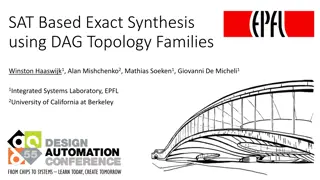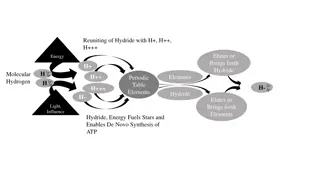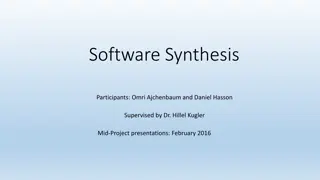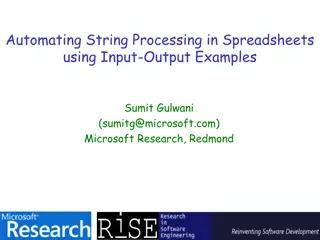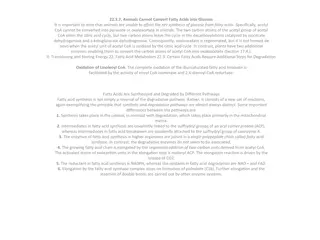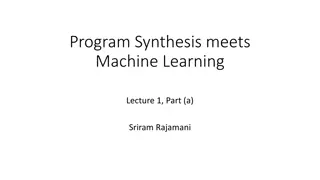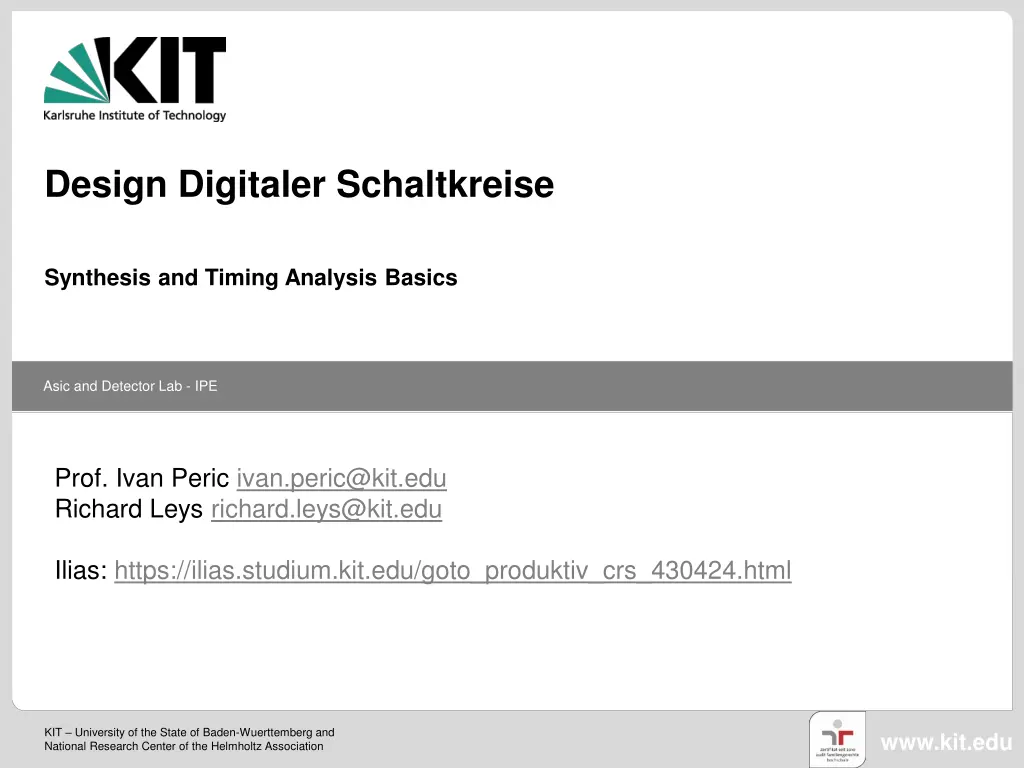
Design Digitaler Schaltkreise Synthesis Basics and Timing Analysis
Explore the fundamentals of digital circuit synthesis and timing analysis in the Design Digitaler Schaltkreise course by Prof. Ivan Peric at KIT University. Learn about synthesis steps, timing libraries, static timing analysis concepts, and timing constraints writing. Join the course to enhance your knowledge in ASIC and Detector Lab.
Download Presentation

Please find below an Image/Link to download the presentation.
The content on the website is provided AS IS for your information and personal use only. It may not be sold, licensed, or shared on other websites without obtaining consent from the author. If you encounter any issues during the download, it is possible that the publisher has removed the file from their server.
You are allowed to download the files provided on this website for personal or commercial use, subject to the condition that they are used lawfully. All files are the property of their respective owners.
The content on the website is provided AS IS for your information and personal use only. It may not be sold, licensed, or shared on other websites without obtaining consent from the author.
E N D
Presentation Transcript
Design Digitaler Schaltkreise Synthesis and Timing Analysis Basics Asic and Detector Lab - IPE Prof. Ivan Peric ivan.peric@kit.edu Richard Leys richard.leys@kit.edu Ilias: https://ilias.studium.kit.edu/goto_produktiv_crs_430424.html KIT University of the State of Baden-Wuerttemberg and National Research Center of the Helmholtz Association www.kit.edu
Lecture Goal Learn the basics of the Synthesis Steps Get used to the required data used by synthesis Sources, Timing Libraries etc.. Learn the Static Timing Analysis concept: Semantic: Timing delay, slew, slack etc Understand setup and hold timing violations See how timing reports look like Learn the basics of timing constraints writing: Clock domain Input/Output constraining 20.08.2025 Prof. Ivan Peric Design Digitaler Schaltkreise 2 Asic and Detector Lab - IPE
Flow overview reminder Final HDL: All logic design + IP are ready, I/Os are set HDL .v .vhd Synthesis Design Data: Libraries, Timing Constraints etc.. Gates LEF LIB SDC DEF Place and Route Add system components: PLL, Extra cells like ESD clamps etc 20.08.2025 Prof. Ivan Peric Design Digitaler Schaltkreise 3 Asic and Detector Lab - IPE
Generic Synthesis Flow Reference Tool Setup LIB LEF checks,reports Load Libraries checks,reports .v .vhd Load Design checks,reports Elaborate checks,reports SDC Load Timing Constraints checks,reports Synthesis S T A DEF Physical Mapped Timing reports Incr. optimisation checks,reports Output .v 20.08.2025 Prof. Ivan Peric Design Digitaler Schaltkreise 4 Asic and Detector Lab - IPE
Timing Library library (uk65lscllmvbbr_090c125_wc) { Seen low level Flip-Flop and Cells in previous lecture Timing Library specified for one corner: Process Information: Voltage Temperature etc Speed Case: Slow, Typical, Fast Timing Libraries provide characterisation of cells: timing arcs between input/outputs Ex: Q to CK Wire loading models Power Pin Capacitance etc Format used in RTL compiler: Synopsis liberty ... nom_process : 1.0 ; nom_temperature : 125.0 ; nom_voltage : 0.9 ; operating_conditions(uk65lscllmvbbr_090c125_wc) { process : 1.0; temperature : 125.0; voltage : 0.9; tree_type : balanced_tree } ... cell(DFQBM1RA) { area : 7.200000 ; cell_footprint : DFQB ; ... pin(QB) { capacitance : 0.000000 ; direction : output ; ... timing() { related_pin : "CK" ; timing_type : rising_edge ; cell_rise(...) { } rise_transition(...) { } ... } ... } ... } 20.08.2025 Prof. Ivan Peric Design Digitaler Schaltkreise 5 Asic and Detector Lab - IPE
Timing Arcs: Delay and Slew SLEW RATE rise_transition(...) { } A rise fall DELAY cell_rise(...) { } B 20.08.2025 Prof. Ivan Peric Design Digitaler Schaltkreise 6 Asic and Detector Lab - IPE
LEF (Library Exchange Format) File LEF files contain physical information for Cells Technology rules and specs can be defined Ex: Number of layers Ex: VIA Definition Cells physical information include: Size I/O (Pins) size and locations Layer obstructions Full layout is not included LAYER VI1 TYPE CUT ; SPACING 0.1 ; SPACING 0.11 ADJACENTCUTS 3 WITHIN 0.14 ; END VI1 ME1 ME2 Using GLADE LEF viewer MACRO SDFQBRM1RA CLASS CORE ; SIZE 6.0000 BY 1.8000 ; SYMMETRY X Y ; SITE CORE ; PIN CK DIRECTION INPUT ; PORT LAYER ME1 ; RECT 1.4400 0.4900 1.5500 0.8900 ; END END CK ENDMACRO 20.08.2025 Prof. Ivan Peric Design Digitaler Schaltkreise 7 Asic and Detector Lab - IPE
DEF File Design Exchange Format Contains Design Data put together: Floorplaning info Netlist etc Used by Synthesis to load floorplaning information Synthesis DEF Physical Floorplan: Size and block, io placements 20.08.2025 Prof. Ivan Peric Design Digitaler Schaltkreise 8 Asic and Detector Lab - IPE
Synthesis Ready HDL: Top Level Two types of Top Level HDL Partition Module: Just I/O which are pins Final Top Level: add instances of real I/O Cells Partition: Just pins Top: With IO Cells 1 module module xxx ( 2 3 input input a, 4 5 ); 6 7 wire a_internal; 8 9 IUMA a_io(.PAD(a),.DI(a_internal)); 10 11 12 mymodule mymodule_I ( 13 14 .anotherinput(a_internal) 15 ); 16 17 endmodule endmodule Io cell Core/internal IO 20.08.2025 Prof. Ivan Peric Design Digitaler Schaltkreise 9 Asic and Detector Lab - IPE
Top Level HDL: IP Blocks (RAM example) All special components acting in the logic design must be instantiated Use Provided Verilog, Timing and LEF from Provider Standard example: RAMS In FPGA, a RAM is an array, mapped by the tool In ASIC,the RAM is instantiated Example in UMC65: 1 module module SJKA65_512X32X1CM4 SJKA65_512X32X1CM4 (DOA0,DOA1,DOA2,DOA3,DOA4,DOA5,DOA6,DOA7,DOA8, 2 DOA9,DOA10,DOA11,DOA12,DOA13,DOA14,DOA15, 3 DOA16,DOA17,DOA18,DOA19,DOA20,DOA21,DOA22, 4 DOA23,DOA24,DOA25,DOA26,DOA27,DOA28,DOA29, 5 DOA30,DOA31,DOB0,DOB1,DOB2,DOB3,DOB4, 6 DOB5,DOB6,DOB7,DOB8,DOB9,DOB10,DOB11,DOB12, 7 DOB13,DOB14,DOB15,DOB16,DOB17,DOB18,DOB19, 8 DOB20,DOB21,DOB22,DOB23,DOB24,DOB25,DOB26, 9 DOB27,DOB28,DOB29,DOB30,DOB31,A0,A1, 10 A2,A3,A4,A5,A6,A7,A8,B0,B1,B2,B3,B4,B5,B6,B7,B8, 11 DIA0,DIA1,DIA2,DIA3,DIA4,DIA5,DIA6,DIA7,DIA8, 12 DIA9,DIA10,DIA11,DIA12,DIA13,DIA14,DIA15, 13 DIA16,DIA17,DIA18,DIA19,DIA20,DIA21,DIA22, 14 DIA23,DIA24,DIA25,DIA26,DIA27,DIA28,DIA29, 15 DIA30,DIA31,DIB0,DIB1,DIB2,DIB3,DIB4, 16 DIB5,DIB6,DIB7,DIB8,DIB9,DIB10,DIB11,DIB12, 17 DIB13,DIB14,DIB15,DIB16,DIB17,DIB18,DIB19, 18 DIB20,DIB21,DIB22,DIB23,DIB24,DIB25,DIB26, 19 DIB27,DIB28,DIB29,DIB30,DIB31,WEAN,WEBN,CSAN, 20 CSBN,CKA,DVSE,DVS0,DVS1,DVS2,DVS3, 21 CKB); .v DO[31:0] LEF 512 x 32 entry size entries 20.08.2025 Prof. Ivan Peric Design Digitaler Schaltkreise 10 Asic and Detector Lab - IPE
Elaboration Parses and compiles the design to an internal logic representation Basically the same as in any other tool: Simulation: irun runs ncelab Check the elaborate output for errors and warnings: Unsupported syntax Connection width mismatches etc.. Example from counter: Tie-high value <= value + 1 20.08.2025 Prof. Ivan Peric Design Digitaler Schaltkreise 11 Asic and Detector Lab - IPE
Synthesis: Principle Two kinds of operations: Boolean logic (& , ! , ^ ) Arithmetic operators (+,- etc ) Principle: Minimize Boolean logic network Map logic and arithmetic to gates and tries to match costs functions: Area Power Timing Main Focus to be chosen: Power ? Area ? Timing? Usually: Meet timing for performance ADHM1RA Sum and Carry out 20.08.2025 Prof. Ivan Peric Design Digitaler Schaltkreise 12 Asic and Detector Lab - IPE
Synthesis: Clock Gating example Clock gating is a good example of synthesis optimisation It can help save power and modifies timing Concept: If a register value changes when an enable signal is asserted, then remove the clock when not changing val change val MUX change Clock Gating No clock gating 20.08.2025 Prof. Ivan Peric Design Digitaler Schaltkreise 13 Asic and Detector Lab - IPE
STA: Overview Gate Level + Timing Constraints enable timing the design Synthesis tries to fix timing during incremental optimisation Important: Synthesis happens during early implementation stage. Its accuracy is not great. Two kinds of checks are performed: Setup: Make sure logic is not too slow (slow corner) Hold: Make sure logic is not too fast (fast corner) Timing Setup for synthesis: Worst case to ensure it will always work Elaborate Synthesis synthesize to_mapped Gate netlist S T A write_hdl > netlist.v .v Incr. optimisation synthesize to_mapped -incr 20.08.2025 Prof. Ivan Peric Design Digitaler Schaltkreise 14 Asic and Detector Lab - IPE
& & STA: Setup Tgate Trc Tgate Tcomb Capture! Launch! Tco Trc Tcomb Logic Trc TSetup Clock to output Interconnect Interconnect FIX: Make faster Positive slack Total + Total - Negative slack 20.08.2025 Prof. Ivan Peric Design Digitaler Schaltkreise 15 Asic and Detector Lab - IPE
STA: Hold Data must remain stable for Thold after clock period: Cannot be too fast FIX: Make Slower Thold Total Positive slack: Slow enough Total + - Negative slack: Too Fast Total 20.08.2025 Prof. Ivan Peric Design Digitaler Schaltkreise 16 Asic and Detector Lab - IPE
STA: Timing Parameters Mostly two types of delays: Gate delays: Input to Output, Clock to output Interconnect Delay (RC extraction) RC extraction is called parasitics extraction: R for wire resistance C for interconnect capacitance Cross-Talking can be extracted (can make RC faster) Cross-talk & R & C Tgate Trc Tgate 20.08.2025 Prof. Ivan Peric Design Digitaler Schaltkreise 17 Asic and Detector Lab - IPE
STA: Physical Synthesis for wire delays RC Extraction was done in the past using statistical models Estimation of wire length was done based on area and fanout Starting at ~0.18 , wire delays become too dominant, so wire delay extraction is required during synthesis -> physical synthesis Synthesis DEF Physical Incr. optimisation S T A Fast Place and route Extraction 20.08.2025 Prof. Ivan Peric Design Digitaler Schaltkreise 18 Asic and Detector Lab - IPE
STA: Setup Timing Report example List of Gates, interconnect and associated timing delay Sum at the end and check against allowed clock period Tcomb Tco Trc Trc TSetup Clock to output Interconnect Interconnect Tgate Trc Tgate Launch! register Tco Trc Type: Empty for Trc, Gate name otherwise Tgate . . . register TSetup Capture! Slack = (capture - uncertainty) - arrival -71ps = (1300 - 150) - 1221 20.08.2025 Prof. Ivan Peric Design Digitaler Schaltkreise 19 Asic and Detector Lab - IPE
STA: Timing report types Previous Slide: Register to Register Other general Timing paths: Register to Output, Input to register, Input to Output input register output register 20.08.2025 Prof. Ivan Peric Design Digitaler Schaltkreise 20 Asic and Detector Lab - IPE
Timing Constraints Specification for the clocks and paths to be timed Format in RTL Compiler: Standard Design Constraints (SDC) The timing analysis uses the constraints to perform analysis Check Tool documentation Path constraint i/o constraint SDC create_clock -name clk -period 1.3 [get_port clk] #750Mhz set_clock_uncertainty 150 -setup clk # Spare time on setup set_clock_uncertainty 50 -hold clk # Spare time on hold set_input_delay -clock clk 50 ... i/o constraint set_output_delay -clock clk 100 .. set_load -pin_load 0.15 [all_outputs] #15pf load on outputs clock 20.08.2025 Prof. Ivan Peric Design Digitaler Schaltkreise 21 Asic and Detector Lab - IPE
TC: Clock Definition Specification: Name of the clock Period/Waveform Start point: Typically the top level input (called port) Uncertainty: Simply Overconstraining to cover unknown wire delay and physical placement information Will be reduced the closer the design gets to its final stage, extraction takes over then. The named created clock is called a Clock Domain Later in Place and route: A Clock tree will be created Name is arbitrary In ns per default 1 module module top ( 2 3 input input wire clk 4 ); 5 6 .... 7 8 endmodule endmodule clk port create_clock -name clk -period 1.3 [get_port clk] set_clock_uncertainty 150 -setup clk set_clock_uncertainty 50 -hold clk Just remove time from period 20.08.2025 Prof. Ivan Peric Design Digitaler Schaltkreise 22 Asic and Detector Lab - IPE
Multi-Mode Multi Corner The may be different constraints, like clock period depending on the mode of operation: Test Mode: Clock fed trough a different slow input, main clock not active Run Mode: Only main clock active One cannot create two clock domains driving the same logic Create two modes, which are analysed separately Corners: Temperature and Voltage combinations Synthesis: Only check modes Place and route: perform extraction and analysis on all corners and modes nT x nV x nM = many corners Limit to the relevants: will my ASIC be in a -40 environment? 20.08.2025 Prof. Ivan Peric Design Digitaler Schaltkreise 23 Asic and Detector Lab - IPE
I/O constraints Input and Output Delay for the outside world Input: When does the input arrive after the clock (setup time from unknown) Output: How Much time is to be spared for the outside How much capacitance do we have to drive Example from counter: overflow hold set_output_delay set_load -pin_load set_input_delay 20.08.2025 Prof. Ivan Peric Design Digitaler Schaltkreise 24 Asic and Detector Lab - IPE
False Paths: Non timed wires Some Special Paths can be ignored Configuration Lines if asserted during total inactivity (like reset) Asynchronous Reset: Reset usually asserted for a long time, so don t need to be timed Wires not relevant to the mode of operation 1 always always @(posedge 2 if if (rst) begin 3 // reset 4 5 end end 6 else else begin begin 7 8 end end 9 end end posedge clk or or posedge begin posedge res_n) begin begin set_false_path -through [get_port res_n] 20.08.2025 Prof. Ivan Peric Design Digitaler Schaltkreise 25 Asic and Detector Lab - IPE
Multi Cycle: timing relaxing Some paths can take more time, like configuration Lines barely changing, or changing when design is inactive anyway They have to be timed anyways to respect setup and hold time set_multicycle_path time -setup -through net N cycles 20.08.2025 Prof. Ivan Peric Design Digitaler Schaltkreise 26 Asic and Detector Lab - IPE
Multiple Clock domains Multiple Clocks can be defined in a design, there are then multiple clock domains Some clocks are derived from each other, like divided clock -> Generated Clocks Timing is respected between the clock domains Separated clocks are uncorrelated, thus false paths are set between flip flops of different clock domains Design should prevent metastability create_generated_clock -divide_by 4 \ name clk_div_4 from clk clk clk1 clk2 clk_div_4 / 4 20.08.2025 Prof. Ivan Peric Design Digitaler Schaltkreise 27 Asic and Detector Lab - IPE
Results Reports: Final timing and other kind of useful information Gate Level Netlist Use to re-simulate the design Go to place and route LEC tools check netlists for equivalence after each transformation: After each synthesis step and incremental optimisation Place and route setup Some scripts to start with encounter In real designs, not used in the end but still works for us Reports 20.08.2025 Prof. Ivan Peric Design Digitaler Schaltkreise 28 Asic and Detector Lab - IPE
End Slide 20.08.2025 Prof. Ivan Peric Design Digitaler Schaltkreise 29 Asic and Detector Lab - IPE












